The publication of the new Collins Bird Guide has, with a few exceptions, set the main taxonomic thrust of the last decade or so in stone for many birders. Museum and field studies have refined the identification criteria for formerly hard to-nail species like American Herring Gull and Taiga Flycatcher, while genetics has been recognised as one of the most important methods of defining a species, in tandem with observations of breeding behaviour and voice.
However, this isn’t the end of the story. Nature’s subtleties continue to confound the human desire to confine each organism to a discrete and diagnosable box. As ornithologists examine the minutiae of bird identification, more new species are likely to be split, renamed and added to the canon of birding lore.
It should be kept in mind that there is still much debate about the definition of species, but for the sake of consistency potential diagnosability under guidelines adopted by the Taxonomic Sub-committee of the British Ornithologists’ Union’s Records Committee (see Helbig et al 2004) is used for this article.
So, where will future splits come from? The biogeography of bird species – that is, their distribution through time and space – provides many of the answers to this question. It is generally accepted under most species concepts that it is reproductive isolation (the absence of gene flow from mating) that keeps distinctive forms separate, and nothing prohibits reproduction more than huge geographical barriers like the Atlantic and Pacific Oceans.
With this in mind, we can see that many prospective splits will derive from species that are widely distributed across the Northern Hemisphere, most notably with counterparts in North America.
Across the great divide
The Atlantic Ocean has been continually widening for the last 130 million years, leading to the ever-increasing isolation of Palearctic and Nearctic avifaunas. Many species pairs have been identified on the two continents, for example Eurasian and American Wigeon, and recently others have been identified and split as separate species, such as Eurasian and American Three-toed Woodpeckers.
Differences between Nearctic and Palearctic subspecies can be slight, mainly involving clustered averages in biometrics and body size, as in Red-necked Grebe, or more obvious plumage differences, as shown by Sandwich Tern. Often, Siberian and American forms can be similar (highlighting a colonisation route across the Bering Strait), and striking differences between Western Palearctic and American forms can often be gradual when an west to east ‘cline’ is taken into account. Such a continuous change generally makes a species ‘unsplittable’ in taxonomic terms.
One division long-mooted among birders is Greenland White-fronted Goose, which superficially appears to be as distinctive as the now widely split Taiga and Tundra Bean Geese. However, this isolated population is probably of recent origin and isn’t viewed as sufficiently differentiated to be a full species by most authorities, though dogmatic application of the phylogenetic species concept might aid its promotion.
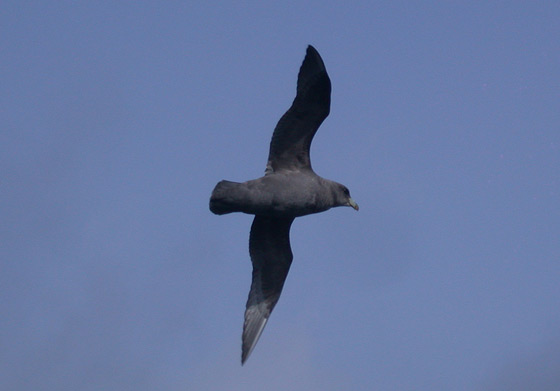
The dark Pacific Fulmar may be a full species. Photo: Chris Harbard
A commonly suggested three- or fourway split of Brent Goose is also unlikely in the near future as it is unclear how much intergradation there is on the breeding territories, so the status of Black Brant and the more mysterious ‘Grey-bellied Brant’ – which still lacks a subspecific name – will remain contentious until more research is undertaken.
The Pacific forms of Fulmar and Kittiwake have both been postulated as species separate from their Atlantic counterparts for a long time in birding circles. There is genetic isolation between the populations of both ‘species’ as well as small plumage differences (with overlap), and in Kittiwake vocal differences have recently been detected, indicating probable incipient speciation. As yet, most authors still consider both to be subspecies, but any extra light- or dark-looking Fulmars or Kittiwakes with more extensive black on their wing-tips should be carefully scrutinised. Interestingly, Pacific Black-legged Kittiwakes are much more likely to possess a hind toe, but this is of little use in the field.
The American subspecies of Great Egret and Night Heron have long been considered as potential vagrants to these shores, but it is likely that only biometrics can tell them apart and any bare part or plumage differences are defined by their average conditions. The absence of yellow on the legs of the American form of Great Egret appears to be the only consistent difference visible in the field. On this basis they are unlikely splits.
Potential list additions
.jpg) |
Northern Harrier is particularly distinctive in juvenile plumage, and has already been seen in Britain, on Scilly from October 1982 to June 1983. Photo: Julian Hough (www.naturescapeimages.net) |
Northern Harrier, or ‘Marsh Hawk’, the North American counterpart of Hen Harrier, has long been known to be distinct in all plumages, as anyone who has seen the brown-hooded, orange-bodied juveniles or an adult male with its two-toned secondaries can attest. The first for Britain, a juvenile, stayed from October 1982 and June 1983 on Scilly. It has already been split by Ferguson-Lees’s significant global review of raptors (and thus is recognised by Birdwatch as a good species), and more widespread acceptance of this decision will surely follow.
The New World form of Rough-legged Buzzard (or Rough-legged Hawk in North America) also differs subtly in size and biometrics. The American form has a dark morph making up around 40 per cent of the eastern population, which is diagnosable and likely to occur here, to judge by presumed and confirmed records from Scilly and Ireland, as well as the Azores. European birds don’t have a dark morph, but juvenile American birds could be confused with the highly variable Common Buzzard with its plain upperparts, all-black tail and rufous-toned underparts.
A long-standing potential cosmopolitan split has been that of Osprey, which has four distinct subspecies around the world, three of which have been considered as species. The American form carolinensis could occur occasionally, as the species is quite common on the eastern seaboard of the United States.
American Osprey has been shown to be as genetically distant from Pandion haliaetus as some eagle species pairs but, as is often the case, gene sequences from across the Holarctic have not yet been published so a clinal relationship cannot be entirely excluded. Observers of Ospreys on the west coast of Britain might be advised to study carefully birds which have lighter breast bands and lighter, less barred primary coverts on the underwing. Watch this space.
Despite observed genetic differentiation between Palearctic and Nearctic subspecies, the circumpolar distribution of Peregrine probably precludes any species-level separation, but the Taiga and Prairie subspecies of American Merlin have to be considered as potential species, and as vagrants too. Merlin appears to have evolved about five million years ago, before the Pleistocene glaciation, and this is reflected in its distinct plumages on both sides of the Atlantic. Gene flow probably ceased a long time ago, and it is possible that the species should be split into Nearctic and pan-Palearctic species accordingly. These two clades seem to be about as separate from each other genetically as Kestrel and Lesser Kestrel, and the variability and distinctive plumages of the American subspecific group accentuate its differences from Eurasian birds.
There have already been two Irish records of so-called ‘Taiga’ Merlin, and a British confirmation can’t be far behind. The North American Taiga and Prairie forms are themselves potentially separate species, with limited hybridisation.
Attention has also recently focused on the possibility that the cachinnans form of Moorhen from North America, sometimes called Laughing Moorhen, is a separate species from its European counterpart. A recent genetic analysis indicated that Moorhen is polytypic, and the North American form differs in voice and frontal shield length and shape. American Coot can make it here, so why not this migratory relative, which has already reached Greenland?
Shore things
Another recent discovery is the relative genetic chasm between the almost identical-looking Snowy and Kentish Plovers, and the relationships of its superspecies are reminiscent of those between Speckled, Green-winged and Common Teal. The Kentish Plover of the Old World is more closely related to White-fronted Plover, an African species, but it will be a brave birder who calls a Nearctic Snowy Plover on field views of a slightly shorter tarsus and wing.The males of both species do have different calls though, and Snowy Plovers in the southern states have lighter plumage tones, though a sun-bleached Kentish could cause confusion.
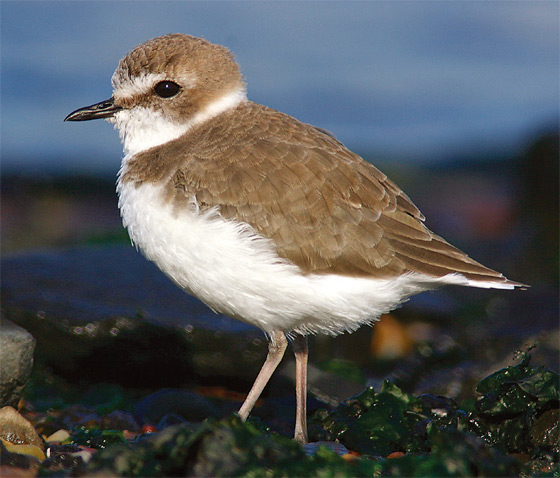
Despite its close similarity to Kentish Plover, Snowy Plover is genetically divergent and now a well-documented split. This American plover is almost impossible to separate in the field. Photo: Julian Hough (www.naturescapeimages.net)
Hudsonian Whimbrel has been a long-awaited split from Whimbrel.This form shows significant genetic differences to shore up its obvious all-dark rump and uppertail coverts, buffier underwings and more striking head pattern. It has occurred several times now since the first on Fair Isle in 1955.
Recent claims of ‘Hudsonian’ Dunlin have to be taken with a pinch of salt, as the form can be tricky to separate in the field from eastern subspecies on current knowledge. But it is unequivocally genetically distinct and there appears to be little gene flow across the Atlantic or Pacific Oceans. Particular attention should be paid to early autumn juveniles with heavily streaked breast sides and flanks, a more marked pectoral band and subtly darker lores.
The discovery of an individual of the American form of Common Gull, also known as Mew or Short-billed Gull, on Terceira, Azores, in 2003 flagged up the possibility of a future British occurrence. While ‘jizz’ can alert an observer to this taxon, only a combination of several characters with detailed notes and photographs will nail it down for the Rarities Committee, though the form has been suspected in the past. Its largely Pacific Coast range means it will be a mega rarity of the order of Glaucous-winged Gull, but some European Common Gull features occasionally overlap and extreme caution is advised when identifying a potential brachyrhynchus.
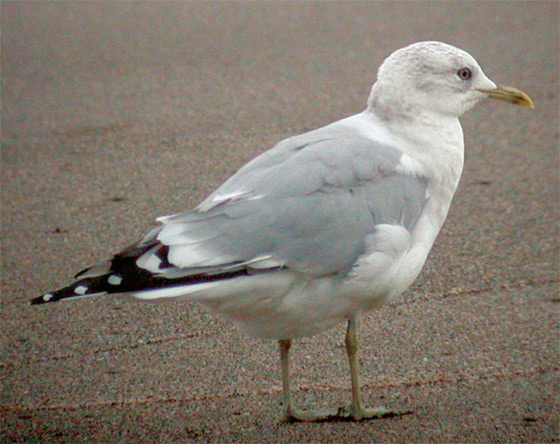
‘Short-billed Gull’, the American form of Common Gull, was identified for the first time in the Western Palearctic on Terceira, Azores, in 2003. A British bird will be tough to clinch, but is expected. Photo: Peter Alfrey
Several tern forms are also distinctive. The American version of Sandwich Tern, potentially split as Cabot’s Tern, has been shown to be more closely related to Elegant Tern. It should be identifiable in first-winter plumage at least, being not only tangibly smaller than its European relative but also having clearly black-centred tertials, while the adults have narrower white fringes to their primaries at rest. Least Tern has been separated from Little Tern for some time according to the American Ornithologists’ Union, a fact which keeps twitchers of the long-staying Rye Harbour ‘probable’ between 1983 and 1992 living in hope – Saunder’s Tern has long been widely split, and the differences in plumage between all three seem comparable.
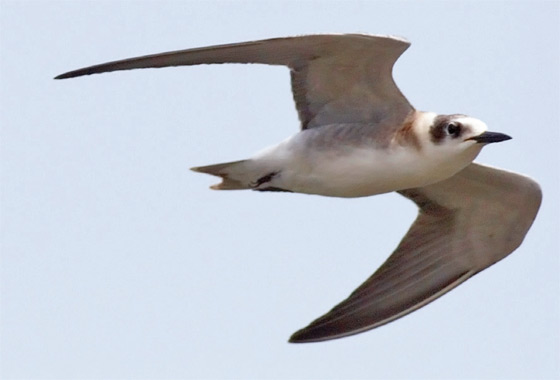
American Black Tern has a distinctive ‘half-way house’ plumage between Black and White-winged Black Terns, and is a long-awaited split, despite its less distinct genetic differences. Photo: Julian Hough (www.naturescapeimages.net)
Most topical to British birders is American Black Tern, following the popular occurrence of the third for Britain at Farmoor Reservoir, Oxfordshire, in autumn 2009 (see Birdwatch 208: 51). Genetically, the subspecies is not as different as its plumage might suggest, being apparently relatively recently derived from the Asian populations of the Eurasian subspecies, but the form is geographically isolated and its plumage is diagnosable at all ages.
Perched on the edge
Interestingly, there are few passerine splits in the offing, perhaps largely because perching birds are less cosmopolitan and more specialised to their natal habitats.
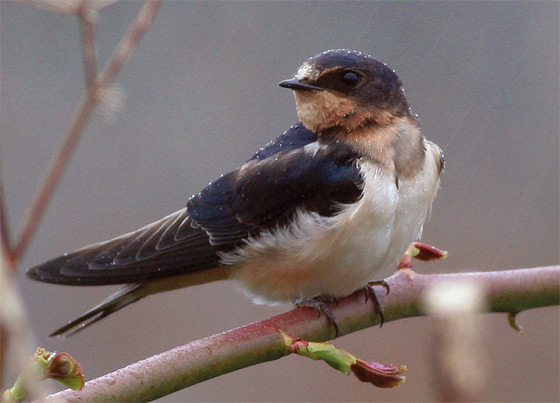
This first-winter American Barn Swallow, with its poorly defined breast band, was one of three on the Azores in autumn 2005. How long before a vagrant bird is confirmed in Britain? Photo: Vincent Legrand
However, a very distinctive New World form is American Barn Swallow, with its distinctive rich orange undersides and a red throat with a negligible border at its base; north-east Asian forms are very similar, and possibly the same subspecies. However, the genetic distance between the two major clades of Swallow is less than the ‘2 per cent rule’ often taken to indicate species status. Three first-winter birds were observed on the Azores in autumn 2005, but the form has yet to be confirmed in Britain.
The American subspecies of Shore Lark has been tentatively identified on Scilly (see Birdwatch 212: 36-39), but an actual split into a diagnosable species is still some way off.
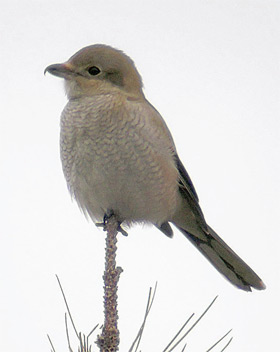 |
Juvenile Northern Shrikes are more heavily scaled and often have a buffier tinge to their underparts than their European counterparts. Already split by some authors, this Nearctic form has been identified twice in Scandinavia and must be on the cards for Britain and Ireland. Photo: Len Blumin (Flickr/photos/redwoodcitylibrary)
|
Great Grey Shrike, however, has been in continuous taxonomic flux for the last couple of decades, but some authors now separate American birds as Northern Shrike Lanius borealis, and the most recent research highlights the probability of six species within the complex, with the recently split Southern Grey Shrike being invalid as it currently stands. Northern Shrike is certainly a potential vagrant being highly migratory, with Western Palearctic records already from Finland and Norway, and any Irish or West Country birds might be wisely scrutinised for brown coloration in first-winters, heavier scaling on the underparts and different calls among other more subtle features.
Where next?
There is an ongoing prospect for serial ‘armchair ticks’ for birders on both sides of the Atlantic and the Pacific. Further research is certainly needed, particularly on the variation of apparently Holarctic or cosmopolitan species, but you can be sure that the splits will keep on coming. Not all, however, will be identifiable in the field.
Perhaps the best way to deal with this is to try to see as many different forms as possible, while being aware of some of the pitfalls and overlap in plumage features – that way, not only will you accrue a larger list by default, but even if an identifiable form never becomes truly ‘tickable’, a wider appreciation of nature’s variability will be gained in the process.
References
For a full list of references, please click here.


